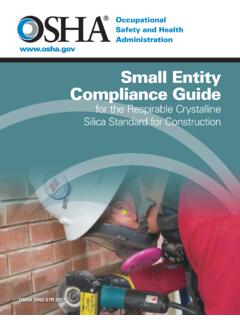Transcription of Stationary Masonry Saws - Occupational Safety and Health ...
1 FactSheet CONTROL OF SILICA DUST IN CONSTRUCTION. Stationary Masonry saws Using a Stationary Masonry saw to cut bricks, concrete blocks, pavers, or other silica-containing materials can generate respirable crystalline silica dust. When inhaled over time, the small particles of silica can irreversibly damage the lungs. This fact sheet describes dust controls that can be used to minimize the amount of airborne dust when using Stationary Masonry saws as listed in Table 1 of the Respirable Crystalline Silica Standard for Construction, 29 CFR Engineering Control Method: Water applied continuously to the saw blade Wet Cutting Check that hoses are securely connected and When using a Stationary Masonry saw, wet are not cracked or broken.
2 Cutting with an integrated water delivery system Ensuring that water flows at the rates that continuously feeds water to the blade is an recommended by the manufacturer. Water effective way to reduce exposure to silica dust. flow rates must be sufficient to minimize the Many Stationary Masonry saws come equipped release of visible dust. with a water basin that holds several gallons of Adjust nozzles so that water goes to the blade water. A pump recirculates the water through a and wets the cutting area. nozzle that directs a continuous stream onto the Rinsing or replacing water filters at blade where it wets the material being cut and recommended intervals. reduces the amount of dust generated. Replace basin water when it gets gritty or begins to silt up with dust.
3 Inspect the saw blade before use to be sure it is in good condition and does not show excessive wear. Indoors or in Enclosed Areas Wet cutting indoors or in enclosed areas may not reliably keep silica exposures low, so extra ventilation or a means of exhaust may be needed Photo courtesy of OSHA. to reduce visible airborne dust. Extra ventilation can be supplied by using: Exhaust trunks Portable exhaust fans A worker cutting Masonry block on a Stationary Masonry saw that Air ducts continuously feeds water to the blade. Other means of mechanical ventilation The saw must be operated and maintained in Ensure air flow is not impeded by the accordance with the manufacturer's instructions movements of employees during work, or by to minimize dust emissions.
4 Focus on the the opening or closing of doors and windows. following areas: Position the ventilation to move contaminated air away from the workers' breathing zones. Respiratory Protection standard 29 CFR Electrical Safety . Where water is used to control dust, electrical Safety is a Additional Information particular concern. Use ground-fault circuit For more information, visit interrupters (GFCIs) and watertight, sealable and see the OSHA Fact Sheet on the Crystalline electrical connectors for electric tools and Silica Rule for Construction, and the Small Entity equipment on construction sites. Compliance Guide for the Respirable Crystalline Silica Standard for Construction. OSHA can provide compliance assistance Vacuum Dust Collection System (VDCS).
5 Through a variety of programs, including technical Some Stationary Masonry saws come equipped assistance about effective Safety and Health with a VDCS to capture the dust generated when programs, workplace consultations, and training sawing. For situations in which wet methods are and education. OSHA's On-Site Consultation not feasible, employers using a VDCS to control Program offers free, confidential Occupational the dust must conduct an exposure assessment Safety and Health services to small and medium- and may need to take additional action. sized businesses in all states and several territories across the country, with priority given Respiratory Protection to high-hazard worksites. On Site consultation When properly used, wet methods can services are separate from enforcement and do effectively control silica dust.
6 Therefore, Table 1. not result in penalties or citations. To locate the in the silica standard does not require use of OSHA On Site Consultation Program nearest you, respiratory protection when using wet methods visit www. osha. gov/consultation. for Stationary Masonry saws . For Stationary saws used with a VDCS by How to Contact OSHA. employers not utilizing Table 1 control methods, Under the Occupational Safety and Health Act respiratory protection may be required if exposure of 1970, employers are responsible for providing monitoring results indicate employee exposures safe and healthful workplaces for their employees. above the permissible exposure limit (PEL) of 50 OSHA's role is to ensure these conditions for g/m3, calculated as an 8-hour time-weighted America's working men and women by setting average.
7 When using VDCS in these conditions, and enforcing standards, and providing training, employers must put in place a written respiratory education and assistance. For more information, protection program in accordance with OSHA's visit or call OSHA at 1-800-321- OSHA (6742), TTY 1-877-889-5627. This is one in a series of informational fact sheets highlighting OSHA programs, policies or standards. It does not impose any new compliance requirements. For a comprehensive list of compliance requirements of OSHA standards or regulations, refer to Title 29 of the Code of Federal Regulations. This information will be made available to sensory-impaired individuals upon request. The voice phone is (202) 693-1999; teletypewriter (TTY) number: (877) 889-5627.
8 DSG FS-3631 12/2017.










